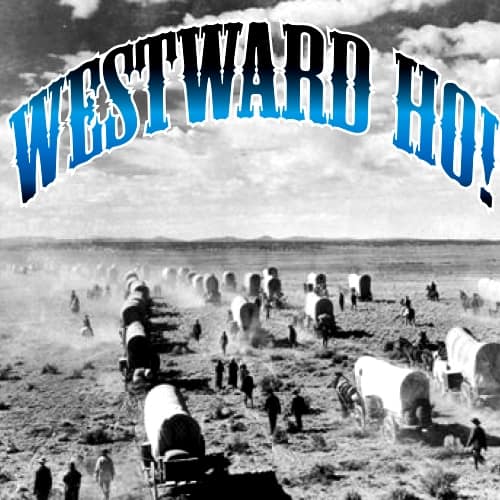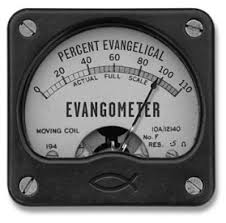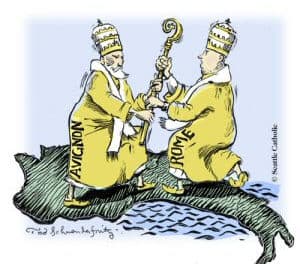In this episode of CS, we take a look at the Expansion of Christianity into the New World.
Following Columbus’s voyages at the end of the 15th C to the Caribbean, the expansion of Christianity into the New Word was chiefly dependent on the 2 great colonial powers, Portugal and Spain. From the outset of their adventures in the New World, a religious intention was central to the efforts of the explorers, however secondary it may have become to conquest and treasure-seeking of their royal patrons back in Europe.
By means of a papal bull in 1493, Pope Alexander VI, divided the world between the 2 kingdoms. Although the line was later moved to allow Portugal to colonize Brazil, the original division was a line drawn from North to Southwest of the Azores [ah-zores] Islands. Spain was given the West Indies and the Americas; while Portugal, because it had already explored the west coast of Africa and moved towards India thru Vasco da Gama’s explorations, was given the right to colonize Africa, India and the East.
It seems monumentally arrogant to us today that these Europeans assumed they were “discovering” lands that already had people living there for generations. And how do you plant a colony in a place indigenous people had called their home for centuries? Yet that was the attitude of many Europeans in the late 15th C and as the scope of geography for the New World was understood, other Europeans joined the rush to grab as much territory as they could. è Because religion was a central and defining part of the European worldview, they took their Faith with them.
Priests accompanied da Gama’s voyages as they were a central part of Spanish colonization, combining the roles of missionaries, explorers, secretaries and chroniclers. Often they belonged to religious orders like the Franciscans and Dominicans, then later, the Jesuits.
It was with a sense of religious mission, as well as the longing to acquire wealth from indigenous peoples, that men like Cortez and Pizarro began their conquest of the Aztec and Incan empires. Modern students of history know that the Spanish conquistadors seemed not to think forced baptisms of native Americans was all that bad of an option. What we do well to remember was that these explorers didn’t originate the policy. Charlemagne had practiced a similar program of forced conversions. That doesn’t make it right, but it provides a little historical context.
Cortez was born in Medellin, Spain. He attended the University of Salamanca and left Spain for Cuba in 1511. At the age of 33 he mounted an expedition against the Aztec capital in Mexico with only 700 fellow Spaniards, but equipped with canons and muskets, reinforced by thousands of Indian allies who’d been brutally dominated by the blood-thirsty Aztecs for generations.
Although he experienced a serious reverse after a massacre of Aztec nobles and temporarily had to withdraw from the capital of Tenochtitlan, he returned to the city in August 1520 and systematically destroyed it. He founded and built Mexico City on the same site, then became governor of New Spain and captain-general of the forces in 1522, titles that were confirmed by Emperor Charles V, when Cortez returned to Europe in 1529. He was later replaced by a viceroy and died in 1547.
His contemporary, Pizarro, directed his attention to the Inca Empire in what would later be the nation of Peru. He obtained authority from Spain for its conquest in 1528–29 and attacked the Incas in 1530. A massacre of native Americans assembled at Cajamarca was followed by the capture of the Inca capital of Cuzco in November 1530.
You may remember from an earlier episode, one of the major debates between the Church and civil rulers of Europe was over who had the right to appoint bishops. While there were seasons when civil rulers took control of this, it was usually the Church that maintained control over church appointments. The New World presented a new challenge and opportunity. The Pope was already busy enough with internal affairs and the threat of the Reformers to be bothered with selecting hundreds of new bishops for lands that hadn’t even been properly mapped yet. So he granted the monarchs of Spain and Portugal the right to select church leaders in their new colonies.
On the colonialist front, a system was developed called encomienda. By this method, a number of native Americans were assigned to a colonist-landlord. He was given rights to both tribute and labor but it was understood he was responsible for Christianizing those committed to his charge. As we’d suspect, the encomienda system became a by-word for oppression and cruelty and resulted in the virtual slavery of the Indians after its introduction in 1503. Brave Dominican priests denounced the system with one of the earliest protestors being Antonio de Montesinos on the island of Hispaniola in 1511.
Bartholemew de las Casas was another Dominican, whose father accompanied Columbus on one of his voyages. When he witnessed the live burial of an Indian leader in 1514 in Cuba, he became a champion of Indian rights for the next 50 years.
I pause at this point to speak to those offended by my use of the term “Indian” for the native Americans of the New World. There are those who believe it’s a slight to refer to inhabitants of the new World as “Indians” because it was a historical mistake on the part of previous generations of Europeans who labeled them as such. BUT! It turns out many native Americans want to be identified, NOT as Native Americans, but as Indians. While they know the errant origin of the term, they’ve embraced it as a self-designation and ask that others identify them as “Indians.”
This is akin to today, to followers of Jesus being more than happy to be known as Christians, though the best evidence says the terms was originally a slur applied by opponents of the Faith to its adherents.
In any case, De las Casas had to confront a widespread European mindset based on a philosophical position going all the way back to Aristotle, that viewed New World Indians as inherently “less human” and so fit to be slaves by nature, an inferior race intended for menial labor and to serve their betters. He worked tirelessly in America and Spain to change this attitude and to convince those in authority that the use of force was contrary to a Christian understanding of the Indians as worthy of respect for those created in God’s image. His efforts to lobby support at home in influential circles, received recognition from the Emperor, against the activities of the colonists. It included a debate in 1550 at Valladolid with the Aristotelian philosopher and scholar, Sepulveda. Before he died, de las Casas’s campaign for just laws for the Indians was responsible for what’s called “the New Laws” of 1542–3, which prohibited slavery and caused the Council for the Indies to be reorganized. After serving as bishop of Chiapas, de las Casas used his pen on behalf of the Indians, most famously in his Brief Account of the Destruction of the Indies, a hard-hitting critique of Spanish practices, in which some claimed he exaggerated abuses. But the work was widely read and proved influential in turning the tide in Europe toward a greater empathy toward the people of the New World.
The Franciscans and Dominicans were the first in the field of the New World from 1510 onwards, but in the 2nd phase of the mission the Jesuits were active.
José de Anchieta was a great Jesuit missionary who gave 44 years of his life and became known as the ‘apostle of Brazil’. He was one of the founders of both the Sao Paulo and Rio de Janeiro Jesuit missions. Another heroic figure and defender of Indian rights in Brazil was the Jesuit, Antonio Vieira, who in equal measure opposed both the Inquisition and colonists, was admired by King John IV of Portugal but almost lynched in 1661 after the king’s death.
In the 17th C, Jesuits were active in Bolivia, Uruguay and Paraguay. In the early 1600s they created a missionary system known as the ‘Reductions.’ These were settlements of Indians that sought to protect them from European colonization while at the same time evangelizing them. In total, these communities comprised some 100,000 people. Each settlement had a church, school and workshops and led an ordered life. The colonists resented the removal of their labor pool but the Jesuits steadfastly defended the Indians against enslavement.
General agitation against the Jesuit order in Europe and colonies of the New World led to their expulsion from Portuguese territory in 1759, then from Spanish possessions 8 yrs later. The Jesuits were suppressed in the New World in 1773. All this was a disastrous blow to the Reductions. It also exposed the weakness of a form of mission that was essentially paternalistic, with little or no authority passed over to the indigenous people or attempt to develop leaders among the Indians. With the removal of the Jesuit leaders, the Reductions collapsed and whole villages were engulfed by jungle after 150 years as oases of Christian community.
The region of modern Venezuela was an area for further Jesuit exploits. They penetrated the jungles of the Amazon to reach large numbers of Indians. One early Jesuit pioneer, Rafael Ferrer, began a mission in 1599 that saw his martyrdom in 1611. Further Jesuit efforts achieved more and by 1661 many thousands were baptized in the region. The Jesuits found that these people were less easily led than the Guarani people who lived around Sao Paulo. There was opposition from the Portuguese; but with assistance from the Franciscans, half a million people were reached.
Central America was pioneered by the Franciscans, Dominicans and a Catholic order we’ve not seen before; the Mercedarians.
Founded by the Spaniard, Peter Nolasco in 1235, their original goal was to ransom captives and redeem properties that had fallen into Muslim hands during the Moorish occupation of Spain. The Mercedarians began as a lay order but by the 14th C the clergy had taken control. Following the Reconquista, when the Moors were expelled from Spain, the Mercedarians continued their mission by traveling to Muslim lands to seek freedom for Christian captives. Gradually, academic, theological, and educational work was included in its work and an order of nuns was founded. They joined the Franciscans and Dominicans in taking the Gospel to Central America.
The first church in Panama was built in 1510. Missionaries entered Guatemala in 1526. By 1600 there were 22 Franciscan and 14 Dominican bases in Guatemala.
Mexico, after the era of Cortez, attracted the orders, so that Franciscans landed at Vera Cruz in 1524, Dominicans in 1526, Augustinians in ‘33, and later, Capuchins and Jesuits. The Franciscan, Juan de Zumarraga, became bishop of Mexico City in 1528 and proved to be a firm defender of Indian rights and a believer in an indigenous clergy. He became the archbishop of Mexico in 1546. The University of Mexico, founded in ‘53, reflected the church’s emphasis on education.
In the north of the country a famous Jesuit missionary, Eusebio Kino, arrived in 1681 and did missionary work in Baja California, up into the modern state of Arizona, and reaching as far as Colorado. Described as a modest, gentle, humble man who was an upholder of the welfare of Indians, he traveled perpetually in the interest of the mission. He hoped to reach the fierce Apaches but died before he could in 1711. Before their formal removal from the region, the Jesuits achieved 37 bases in Baja by 1767.
In the modern state of California, a string of Franciscan missions are still to be found between San Diego and San Francisco. Father Junipero Serra, born in Majorca, became the leader of the mission and founded the communities of Monterey, Carmel, San Luis Obispo, Santa Barbara, and several others. While many of the original buildings are gone, Catholic churches continue on in several of these sites to this day. By 1800, some 100,000 Californian Indians, many from the Chumash people, had been reached by the mission and 18 Franciscan mission compounds were established. At least some of the thrust to the N was driven by Spanish fear of Russian incursion, moving S from Alaska. Father Serra also spent some years establishing a work in Texas.
Regarding Junipero Serra, when I originally composed this episode, Pope Francis had recently arrived in the US where he addressed both the US Congress and the United Nations. While in the US, he canonized, that is, he conferred sainthood, on Serra. That had been an issue of some controversy for a while as Serra’s career came under fire from some historians and human rights advocates.
Critics claim Serra’s methods ranged from harsh to brutal. Lashings of the Indians were used liberally in the missions for infractions as small as asking for more food. The friars kept meticulous records so historians are able to document this treatment. The problem comes in interpreting these records. The language isn’t the problem; it’s the cultural context that makes interpretation difficult.
On one hand, Serra was devoted to protecting the Indians from exploitation by adventurers and settlers who wanted to reduce the native population to slavery. Serra understood people are led to faith by kindness and love rather than heavy-handedness. That he traveled so far, pioneering several missions proves he wasn’t driven by some kind of personal profit motive. So why the harsh treatment of the Indians at so many of the missions? Defenders of Serra say such treatment was necessary because of the nature of the cultures of the natives where the Missions were located.
What we can say is that the Missions definitely went far to alter the tribal life of the Indians where they were based. If they began as attempts to Christianize Indians while allowing them to continue some of their native traditions, they ended up going much further in converting the Indians not just to the Faith, but to the Spanish culture. And it seems that more than anything raises the ire of at least some of Serra’s critics.
As we end, just a quick reminder that CS is supported by the donations of subscribers.





